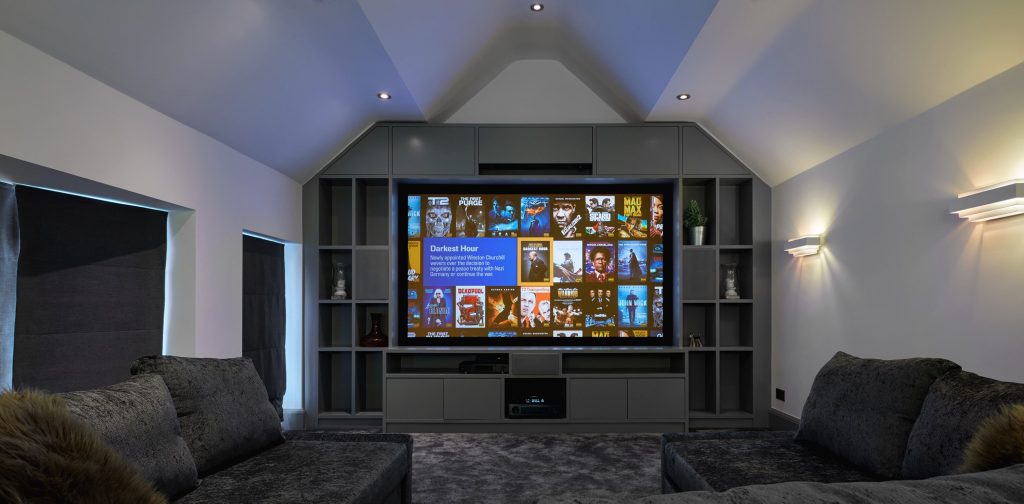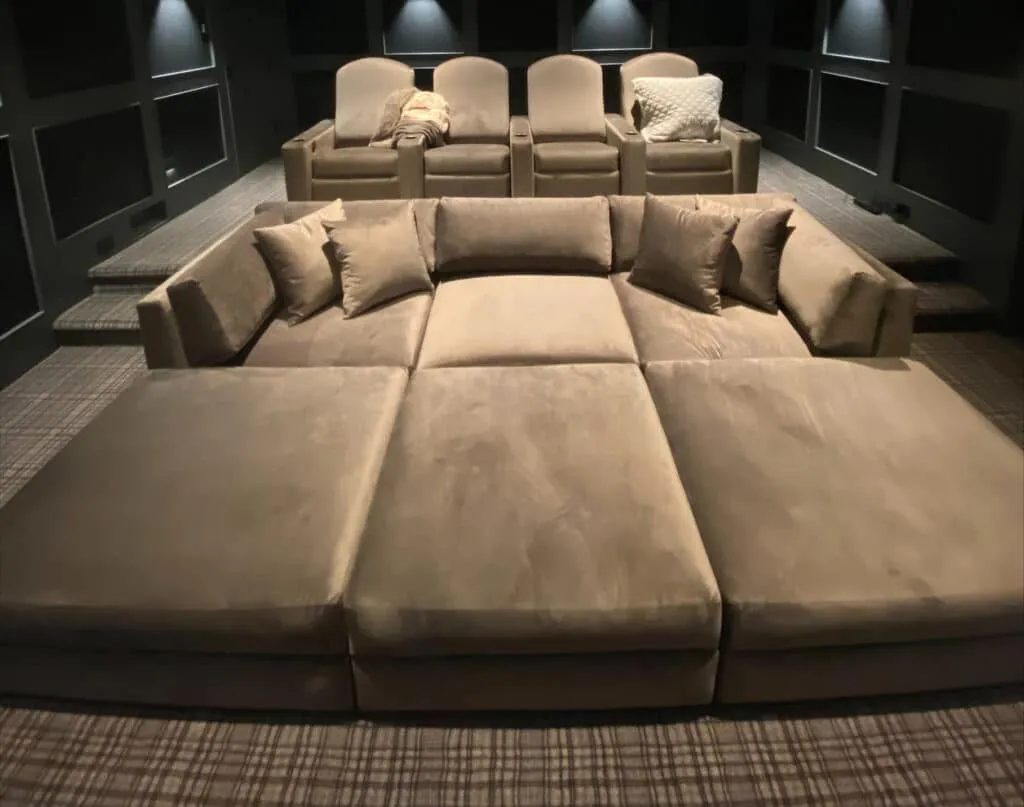Media rooms have evolved from simple television spaces to sophisticated sanctuaries of entertainment and relaxation. In today’s fast-paced world, these multifunctional spaces offer a quintessential escape for cinephiles, gaming enthusiasts, and those seeking a sophisticated home entertainment environment.
Media Room Ideas
The metamorphosis of media rooms reflects our changing relationship with technology, comfort, and personal leisure, transforming mundane spaces into immersive experiences that captivate and rejuvenate.
1. Cinematic Sound Design

Modern media rooms transcend visual experiences by prioritizing acoustic perfection. Sound is the invisible architecture that breathes life into entertainment, creating emotional landscapes that transport viewers beyond physical boundaries.
Professional audio systems with strategically placed speakers can transform an ordinary room into a sonic masterpiece. Consider investing in surround sound systems that provide directional audio, ensuring every whisper and explosion feels incredibly realistic. Acoustic panels can further enhance sound quality by minimizing echo and improving overall audio clarity.
2. Luxurious Seating Arrangements

Comfort is paramount in creating an exceptional media room experience. Ergonomic and stylish seating can dramatically elevate the entire entertainment atmosphere.
Home theater recliners with built-in cup holders, USB charging ports, and adjustable positions represent the pinnacle of viewing comfort. Consider tiered seating arrangements that provide unobstructed views, mimicking professional cinema layouts. Leather and high-performance fabrics offer durability and aesthetic appeal, ensuring your seating remains both functional and visually striking.
3. Smart Lighting Solutions

Lighting plays a crucial role in creating immersive media environments. Intelligent lighting systems can transform room ambiance with minimal effort.
Dimmable LED strips, color-changing smart bulbs, and automated lighting controls allow precise mood management. Ambient lighting behind screens reduces eye strain and creates a cinematic atmosphere. Consider installing bias lighting that complements screen colors and provides subtle illumination during movie nights.
Related Guide: 12 Creative Game Room Ideas
4. Cutting-Edge Projection Technologies

High-definition visual experiences are the cornerstone of modern media rooms. Advanced projection technologies have revolutionized home entertainment possibilities.
4K and 8K projectors deliver unprecedented image clarity and color reproduction. Laser projectors offer longer lifespans and superior brightness compared to traditional lamp-based systems. Motorized screens that descend from ceilings provide a clean, minimalist aesthetic when not in use.
5. Soundproofing and Acoustic Treatment

Creating an immersive media experience requires managing external noise and internal sound dynamics. Professional soundproofing techniques can transform ordinary rooms into acoustic sanctuaries.
Incorporate sound-absorbing materials like specialized insulation, acoustic panels, and mass-loaded vinyl to minimize external noise intrusion. Double-layered drywall with sound-dampening compounds can significantly reduce sound transmission, ensuring your media room remains an isolated entertainment haven.
6. Integrated Gaming Zones

Modern media rooms increasingly accommodate diverse entertainment preferences, with gaming becoming a central attraction.
Dedicated gaming stations with ergonomic chairs, high-refresh-rate monitors, and advanced cooling systems create optimal gaming environments. Consider mounting large screens or installing multiple monitor setups to enhance competitive and immersive gaming experiences.
7. Versatile Storage Solutions

Effective storage management ensures your media room remains organized and aesthetically pleasing. Custom cabinetry and innovative storage designs can seamlessly integrate technological components.
Built-in shelving units with ventilated compartments protect electronic equipment while maintaining clean aesthetic lines. Consider motorized cabinets that conceal equipment when not in use, preserving the room’s sophisticated appearance.
8. Climate and Comfort Control
Temperature and humidity significantly impact entertainment experiences. Advanced climate control systems can create consistently comfortable environments.
Zoned temperature controls, smart thermostats, and strategically placed ventilation ensure optimal comfort. Consider installing ceiling fans with silent operation modes to improve air circulation without disrupting audio experiences.
9. Multi-Purpose Design Concepts

Contemporary media rooms serve multiple functions beyond traditional entertainment spaces. Flexible design concepts accommodate diverse activities and preferences.
Modular furniture, convertible seating arrangements, and adaptable layouts enable seamless transitions between movie nights, gaming sessions, and social gatherings. Consider designs that allow quick reconfiguration to suit different entertainment needs.
10. Connectivity and Smart Home Integration
Technological connectivity transforms media rooms into intelligent, responsive environments. Smart home integration provides unprecedented control and convenience.
Centralized control systems that manage audio, visual, lighting, and climate settings through single interfaces represent the future of home entertainment. Voice-activated commands and smartphone applications offer intuitive control mechanisms.
Related Guide: 12 Creative Playroom Ideas
11. Aesthetic Color Schemes

Color psychology plays a significant role in creating immersive media room experiences. Thoughtful color selections can enhance emotional engagement and visual comfort.
Dark, neutral colors like deep grays, navy blues, and black minimize light reflection and create cinema-like atmospheres. Accent colors can add visual interest without compromising the room’s primary entertainment functionality.
12. Ergonomic Equipment Placement

Strategic equipment placement ensures optimal viewing and interaction experiences. Thoughtful design considers viewing angles, equipment accessibility, and overall room functionality.
Mount screens at eye level to reduce neck strain. Position speakers symmetrically for balanced sound distribution. Create cable management systems that maintain clean, organized appearances while ensuring efficient equipment connectivity.
Conclusion
Designing the perfect media room requires a harmonious blend of technology, comfort, and personal style. By carefully considering acoustic treatments, visual technologies, seating arrangements, and smart integrations, you can create a transformative entertainment space that transcends traditional viewing experiences.
Remember that the most exceptional media rooms reflect individual preferences, balancing cutting-edge technologies with personal comfort and aesthetic sensibilities.

